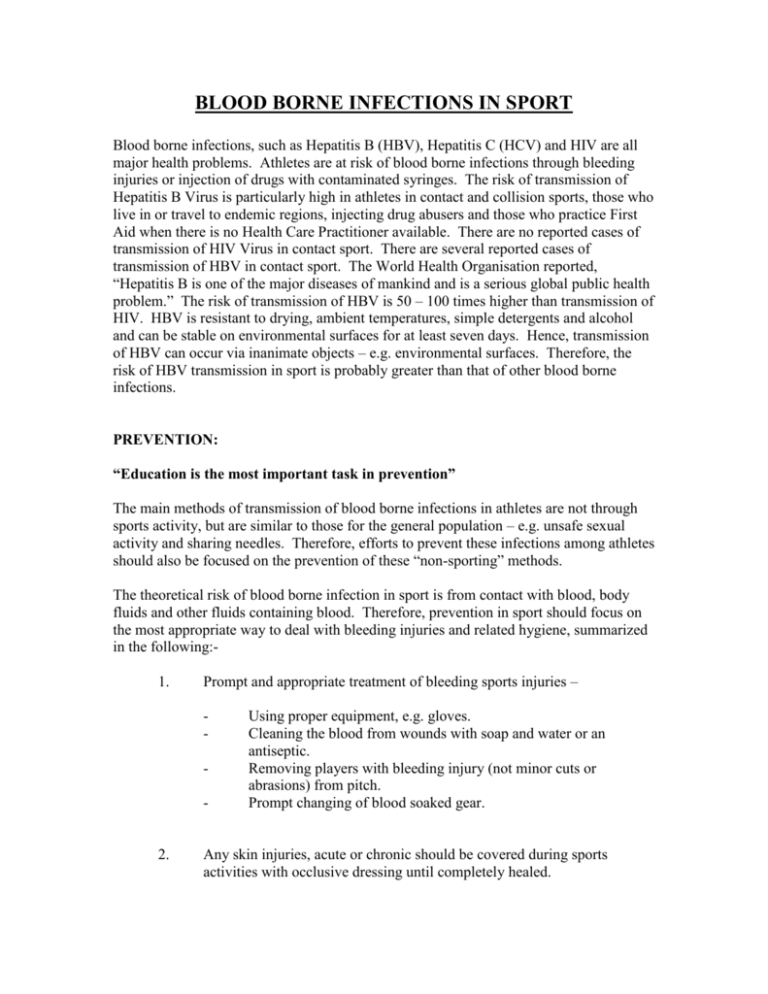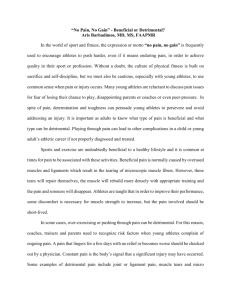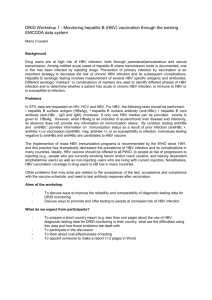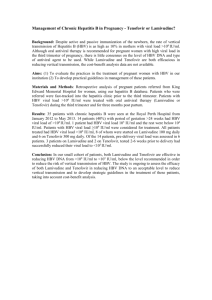Blood Borne Infections in Sport (Hepatitis B)
advertisement

BLOOD BORNE INFECTIONS IN SPORT Blood borne infections, such as Hepatitis B (HBV), Hepatitis C (HCV) and HIV are all major health problems. Athletes are at risk of blood borne infections through bleeding injuries or injection of drugs with contaminated syringes. The risk of transmission of Hepatitis B Virus is particularly high in athletes in contact and collision sports, those who live in or travel to endemic regions, injecting drug abusers and those who practice First Aid when there is no Health Care Practitioner available. There are no reported cases of transmission of HIV Virus in contact sport. There are several reported cases of transmission of HBV in contact sport. The World Health Organisation reported, “Hepatitis B is one of the major diseases of mankind and is a serious global public health problem.” The risk of transmission of HBV is 50 – 100 times higher than transmission of HIV. HBV is resistant to drying, ambient temperatures, simple detergents and alcohol and can be stable on environmental surfaces for at least seven days. Hence, transmission of HBV can occur via inanimate objects – e.g. environmental surfaces. Therefore, the risk of HBV transmission in sport is probably greater than that of other blood borne infections. PREVENTION: “Education is the most important task in prevention” The main methods of transmission of blood borne infections in athletes are not through sports activity, but are similar to those for the general population – e.g. unsafe sexual activity and sharing needles. Therefore, efforts to prevent these infections among athletes should also be focused on the prevention of these “non-sporting” methods. The theoretical risk of blood borne infection in sport is from contact with blood, body fluids and other fluids containing blood. Therefore, prevention in sport should focus on the most appropriate way to deal with bleeding injuries and related hygiene, summarized in the following:1. Prompt and appropriate treatment of bleeding sports injuries – - 2. Using proper equipment, e.g. gloves. Cleaning the blood from wounds with soap and water or an antiseptic. Removing players with bleeding injury (not minor cuts or abrasions) from pitch. Prompt changing of blood soaked gear. Any skin injuries, acute or chronic should be covered during sports activities with occlusive dressing until completely healed. 3. All wounds and injuries should be promptly detected and reported by players and coaches. 4. Appropriate protective equipment should be used at all times, including mouth protectors. 5. Any equipment contaminated with blood should be removed from the sports activity area. If this is not possible, the item should be cleaned and dried appropriately, using disposable cloths and a fresh solution of 1 part household bleach and 10 parts water. Education is the most important task in prevention. Athletes, their families, health care providers, coaches, officials and others involved in sports should be educated. VACCINATION HBV infection can be prevented by vaccination, which is safe, and 95% effective. Some influential groups such as Sports Medicine Australia have strongly recommended that “all participants involved in contact/collision sports and playing under adult rules, be vaccinated against Hepatitis B”, and The American College Health Association has recommended Hepatitis B immunization for all student athletes since 1994. Universal vaccination of children and adolescents, before the age of 13, has been recommended. It is anticipated that Hepatitis B vaccination will be included in the routine childhood vaccinations, countrywide in the future. DR. D. MULVIHILL Medical Science Welfare Committee, Croke Park. 1st February 2007 NOTE ON VACCINATION PROCEDURE (Added for Antrim Website) Players should contact their local GP surgeries/health centres re this - in most cases this can be arranged with the nurse and an appointment with a GP will not normally be necessary.











